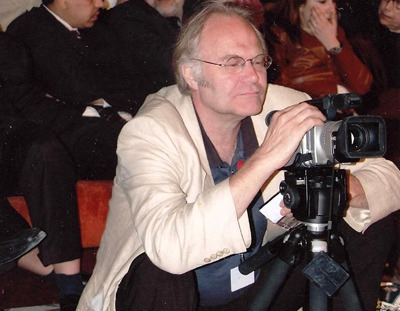The Business of Art: A Conversation with Richard Marriott
For over 30 years Richard Marriott has been active as a composer, performer, and instrument builder. He has written extensively for film, television, dance, video games, interactive art installations, and opera. His recent compositions are notable for their seamless mixture of western and eastern elements, reflecting his studies with a variety of musicians—Pauline Oliveros, Dominick Argento, Ali Akbar Khan, and Masayuki Koga—representing divergent cultural approaches. Marriott has written four operas and has collaborated with dance professionals and theater companies such as Della Davidson Dance Company, ShadowLight Productions, Yoshiko Chuma, California Shakespeare Theater, and Christopher Beck Dance.
As a wind player extraordinaire (primarily trombone, eastern and western flutes, clarinet, and trumpet) he has appeared on stage and in recordings with the likes of Snakefinger, The Residents, Gamelon Darma Swara, and an uncountable amount of jazz and free jazz ensembles. His instrument inventions include the “Voltage-Controlled Casio”—sold to musicians such as The Residents, Throbbing Gristle, Captain Beefheart, Mothers of Invention, Tuxedomoon, and John Adams. If all this weren’t enough, Marriott was Senior Composer for Atari Games from 1992-1997.
As founder and Artistic Director of the Club Foot Orchestra, an ensemble renowned for its live “accompaniment” of silent films, Marriott has been the primary innovator of silent film scores since the mid-1980s. His compositions are outstanding partially due to what pianist Sarah Cahill has likened to a “bricolage” sensibility, coined by Claude Levi-Strauss as “an arrangement of already existing elements which, when you organize them differently, take on new properties.” The films that he has scored include The Cabinet of Dr. Caligari, Nosferatu, Metropolis, and Battleship Potemkin.
I first met Marriott a few years ago at Bard College, where we both performed in our respective gamelan ensembles. He approached me before the show and said that my facial characteristics resembled those of an old teacher of his… Serge Tcherepnin. It turned out that he had worked for my uncle at Serge Modular in the early 1980s building analog synthesizers and gaining inspiration for his own instrument designs. I have since worked with Marriott in the New York-based gamelan ensemble Dharma Swara, with whom I played his composition “Gong Bone.” After a recent rehearsal, Marriott and I met at his apartment where we discussed some of these cosmic connections, as well as ideas about film scoring, multimedia performance, electronic synthesis, and world music.
Sergei Tcherepnin: Let’s start with a little background. How and when did you become interested in scoring silent films?
Richard Marriott: In the mid-1980s, the Club Foot Orchestra was playing music that was dramatic, complex, and surreal for late-night audiences in San Francisco, and I became interested in doing something visually that further expressed the ideas behind the music; something that would help put the music in context. I considered projecting slides of experimental art on a screen behind us. Then a friend suggested, after catching our show: “The music is so cinematic, why don’t you take outtakes of 1950s sitcoms and score them.” I put it under my hat.
Later that night I saw a Lily Tomlin skit on Saturday Night Live. She was reading the Dow Jones averages of various art trends. She reported, “Pop art up 10… Op art up 20… Expressionism down 30.” I turned the channel. And there was The Cabinet of Dr. Caligari. The distorted sets and dreamlike atmosphere in the film were the qualities that I always envisioned accompanying our music. The subversive plot was drenched in the unconscious. I was obsessed with writing for that film. Just the way the shadows fell on the sets, it was just like, ‘That is it. That is it—I hear it—I hear that dissonant chord.’
ST: So, you were first inspired by the striking visuals of Dr. Caligari. Yet at the same time most of the films that you score are narratives. Are you more interested in films for their value as visual stimulation for the creation of audio textures or as dramatic narratives which drive the music forward?
RM: I’m interested in both, and I think the best movies are those that explore design in the context of a dramatic arc. That said, it is sometimes challenging to demand the attention of audiences with a movie that is primarily design, without an overt narrative. The expectations and emotions of an audience are an intoxicating presence whenever we perform. It’s an equal partner in the event. I like to balance episodes of drama and episodes of design, and I find inspiration in filmmakers like Eisenstein and Kubrick who share this aesthetic.
I see design—the image—as simply another voice that works with the music, as an equal partner. The music doesn’t accompany the image. The reason to score films was to have an image that could dance with us, that could interplay with the music; sometimes the film will take a lead, sometimes the music will take a lead.
Now, in a narrative, music actually has a different place. The image tells you the what and where; the music tells you the why. There’s very little to be gained from a visual without sound. It doesn’t tell you anything. It just tells you kind of where the objects are located. But it doesn’t tell you why anyone is doing anything. And that’s what the music’s job is—it gives you the subtexts of the motivations.
ST: So for instance in the “precious blood” scene of Nosferatu, the music all of a sudden becomes extremely sexual as the orchestra, previously playing an eerie texture featuring a violin glissando, breaks into an all-out burlesque, which gives the subtext in a certain way…
RM: The subtext is that the vampire is a powerful being and he’s acting on his own lust, which keeps him alive. He’s 400 years old. It’s the lust that keeps him alive.
ST: So you’re actually, by identifying with that lust, remaining very true to the actual text.
RM: Yes. As opposed to what a horror movie usually does, which is identify with the victim. I mean it does that for a purpose—to scare the audience, give the audience a thrill. We identify with the vampire—a 400 year-old exotic creature. And actually if you look at the scene filmically, the vampire is much more interesting than the innocent character, Harker.
ST: That’s actually usually the case in horror movies, I think.
RM: Certainly. But very seldom does the music reflect the view of the monster.
ST: In Legong: Dance of the Virgins, which is not a horror movie but a heart-wrenching love story, I noticed that the music doesn’t necessarily follow the emotional contours of the film. For instance it doesn’t do the usual thing of imposing a very cheesy, drawn-out theme at the end. Instead there is a sense of inevitability about the story reflected in the music all the way through the film. When the dramatic upset happens, the music reacts very minimally, giving the feeling that “this is life.”
RM: You know, it’s not necessarily by design. It’s just the way it happened. But that’s probably why I didn’t go further in Hollywood—because I don’t really like cheesy endings.
ST: Other than your scoring of Twisted Tales of Felix the Cat and Rising Sun, you have steered clear of the TV and film industry. One advantage of this is that you have total freedom in the films that you choose and what you do with them. Do set your own visual or dramatic criteria for the silent films you score or do you choose films purely by intuition?

Performance view of
Club Foot Orchestra
performing live to Nosferatu
RM: I used to have very exacting standards. I really like drama. I just like being able to take the music and have it really go some places. Design is fine. Something that is simply designed is great, but only for so long. You can use design elements for anything. But it’s the drama that I actually find interesting. Or it’s the most fun. “Most fun” means that you play it and the audience reacts. Just like with Nosferatu. There’s nothing like getting people to stand up in the middle of the audience or in the middle of the show and yell things. The end of Nosferatu is such a psychosomatic event. About 20 seconds from the end I could look at the movie, I could feel our tempo, and I could tell if we were going to get a standing ovation or not—because if we hit this one thing right people would feel impelled to stand up and cheer, ’cause that was just the way it worked. Actually, during the vampire scene—“your precious blood”—people would stand up and scream.
ST: The active involvement of the audience seems to be an important part of your work. This is apparent from your activities with Atari as a composer/sound designer for video games, your work with silent films, and your operatic writing. You also described the Club Foot Orchestra as having an egalitarian atmosphere in which everyone can participate. What are your thoughts on this subject?
RM: It’s my experience that an actively engaged audience will help produce a superior performance. Art is all about communication. When art lovers are lined up five or six deep around The Garden of Earthly Delights they are partaking of the spiritual power of that work. When a member of the Castro Theater audience stood up and screamed during the burlesque in Nosferatu, that intensity was both feedback for the performers and permission to go farther. As the opening character in Fellini’s Amarcordrapturously declares, “It circulates!” It’s the ability to find new meaning that keeps the audience engaged. In an interactive work, the audience makes a decision and the artwork responds, often quite overtly, with new meaning. Presently with games, it’s a new set of enemies or a new environment or puzzle; but in the artwork of the future, it may become an intimate dance with the brain, enhancing creativity, uncovering buried emotions and memories.
ST: You have taken this idea further in your opera God Machine, in which the audience really does determine the outcome of the story—what is the premise of God Machine and how exactly did this interactive element work?
RM: God Machine is about the self-realization of an artificial human and how it develops through the power struggle between the forces that created him and the forces he must obey. In God Machine each member of the audience is furnished with a ping-pong paddle that is painted black on one side and white on the other. The audience is asked a series of statements, which they answer by presenting the white side of the paddle towards the stage if they agree, the black side if they disagree. The relative luminosity is recorded by a camera and the data is relayed to a computer running MAX, a program that gives the antagonists different weights derived from the audience’s responses and changes the plot accordingly. It’s my intention to have each performance subtly different in meaning based upon the psychology of the audience involved. If it could happen in games, why not in opera?
Like all composers, ancient or modern, the world we live in provides us with the materials we use in our art. Technology has given us interactivity, electronically processed voice, new sounds, and new procedures. Modern life has imbued them with meaning, and they have entered our subconscious mixing with the music we’ve heard, written, or imagined, becoming the new music.
Sergei Tcherepnin is a composer/performer of New Music currently based in Brooklyn.
The Club Foot Orchestra will play live to The Cabinet of Dr. Caligari on June 15 at 7 pm at the Morgan Library (225 Madison Avenue) in New York.





